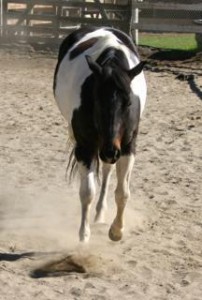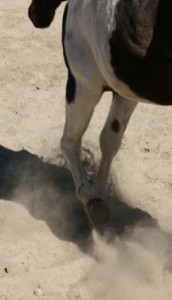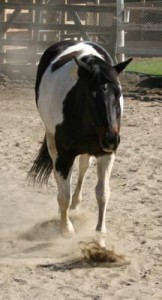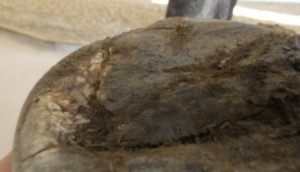Started 3/26/2014

Armani is a 2003 Registered Oldenburg Gelding who was originally purchased to be an Event horse, and I began trimming him on July 18th, 2011. He had an extreme long toe and low heel on his front right hoof. The side view of the hoof revealed an extreme under-run heel and the sole view revealed extremely contracted heels, indication of a negative palmer coffin bone rotation and a rotten frog.
His front left had a higher heel, but it wasn’t club / pathologically high.
At the time, Armani was coming back from a tendon injury on the right front. His owner, vet and farrier had struggled unsuccessfully to correct the long toe and chronic lameness he was experiencing, and the owner decided to try barefoot. The lameness caused enough concern that she was considering retiring him even though he was young and was otherwise a wonderful athlete. She discussed barefoot with her vet who said he wasn’t a good candidate, but admitted that she “had nothing to loose”.
NEGATIVE PALMER ANGLE
The x-rays below were taken 3 days pre-trim, and show the right front prior to starting to my starting to trim it. If a DP View (front view) of a hoof where the x-ray beam is aimed at the base of the coffin bone reveals an upward arc to the base of the coffin bone, its an indication that the hoof is “reverse Palmer” (front hoof) or “reverse plantar” (hind hoof). “Reverse” means that the toe is at a higher point relative to the ground than the heel .


A healthy Palmer angle is almost a matter of pinion, but negative is always undesirable. I like to see a heel that is 2 to 4 degrees higher behind because the heel compresses under maximum load, and I never want the angle of the coffin bone to go into a reverse position. Reverse Palmer angles put considerable stress on the tendons and ligaments, predisposing the limb to injury This is what was happening to Armani.
MORE ON NEGATIVE / REVERSE PALMER PLANTAR
When you look at a hoof and want to determine if the palmer or plantar angle is negative, here are several things to look for. The only way to know for certain is with an x-ray, but these landmarks help guide my work.
- The frog is stretched forward and the heels are frog are contracted.
- There is typically a deep dip or cup directly in front of the tip of the frog.
- The sole is often flat, at least around the peripheral wall.
- The heels are often crushed.
- The Coronet band has a steeply upward angle and the profile shows a bull-nose. On a rear hoof, the coronet band projected up should aim at the elbow, and on a reverse P foot, it will point at the abdomen.
- Horse may stand under if its a negative Plantar angle

Crushed heels

Steep coronet band points at abdomen

Stands under behind
LONG TOE, LOW HEEL
The horse is meant to land heel first under most circumstances. An emphasis on loading the toe pulls on the wall with each step. Horses will sometimes land toe first on a hill with a healthy foot, or for traction, but that an exception. In order for the horse to land heel-first, he needs a heel that he can land on. Unfortunately the heel below is under-developed and under run… it’s super uncomfortable.

When we look at an extremely long toe on a clearly marked x-ray, the toe is obviously long. There are several consequences of having a long toe and low heel. Think of the hoof capsule as a rectangle, a parallelogram. A healthy hoof is a more upright parallelogram with a dorsal wall angle approximately between 45 and 55 degrees. An unhealthy hoof with a long toe appears squashed flat with an angle lower than 45 degrees (depending on the hoof and horses conformation). The length of the bottom of the hoof B below, stays the same, but when the horse lands toe first chronically, the height, H, is reduced and the amount of under-run in the heel, A, increases. The Hoof Angle on a normal hoof is typically greater than 45 degrees, but this is dependent on the horses coffin bone shape and the horses conformation.
A pathologically long toed hoof can be viewed as a parallelogram. If you continuously load point the toe, exert pressure on it, it will respond to that pressure by moving forward relative to the top of the dorsal wall at the coronet band. The heel is going to get pulled forward and under the hoof. When this happens, it becomes even more uncomfortable to load the heel, first because that point is now so far under the hoof that the foot is thrown into a more extreme reverse palmer angle.

In a case like the picture of Armani’s sole in the contacted hoof above, the heel is very weak, so the horse prefers not to land on it, weighting the toe-first instead. As the toe is stretched forward, the frog is also stretched forward and the heels are drawn in, contracting.

In the second picture above, the heels are loaded comfortably, the area between the heels and above the frog – the Digital Cushion – becomes firm and healthy, and spreads the heels out.
Here’s a video that shows an unhealthy and healthy digital cushion dissection:
http://www.youtube.com/watch?v=o8K184QkJAU
The less comfortable the back of the hoof (referred to as the Caudal Hoof) is, the less likely the horse is to use it. When we trim the hoof correctly (keeping the toe short), then make the back of the foot comfortable (I prefer using boots and pads, or glue on synthetic shoes), the horse starts to use the heel correctly and the Caudal Hoof (digital cushion, lateral cartridges, heels and frog) begins to develop a healthy shape.
Below are cadaver pictures that illustrate what a pathologically underdeveloped digital cushion looks like compared to a mustang digital cushion.
Toe First Landings?
These pictures come from Promises Case Study, http://healthyhoof.com/case_studies/Promise/Promise.html , and illustrate what a toe-first landing looks like. When a horse hits the ground toe first, one of the first things I notice is the puff of debris that flies up in front of the hoof. Other things to look for are a stiff pastern/fetlock that drops sharply vs smoothly and tension in the withers or hip.
The picture below left is a toe-first canter stride. The picture on the right is “after” and heel first.
More Before Pictures
The first picture below is immediately after shoe removal. I trimmed the hoof very conservatively. I brought the toe back and removed some of the deep sole under the tip of P3 to lower he toe and improve the reverse palmer angle. I don’t show this because if you don’t know what you’re doing, you can injure the horse so its a more advanced topic.
Two weeks later, all of the retained sole began to soften and come out, as shown in the other three pictures.
Because the hoof is in a healing process, I err on the side of being too conservative and wait until the sole and bar starts to shed before removing it. I have taken “retained sole” or bar out on other horses and had them become very tender. A comfortable hoof and lots of heel first movement are a key part of the rehab process, so I typically leave this ugly sole and bar intact.
Rehab Process?
BOOTS
In Armani’s case we booted him in Easy Care Trail boots with 1/4 soft pads. I recommend using Gold Bond or a similar Talc powder and shecking the boots every day. If a horse develops rubs, a strip of duck take or athletic tapr over the rubbing area helps, or cut the toe out of a mans wook hiking sock and pull that over the foot. Rubbing is rarely a problem if the hoof is trimmed correctly and the boot fits.
Several other boots would work as well. The new Easy Care Transition and RX boots are made specifically for rehab, and the Back Country Glove and Cavello work well too. Some people like the Soft Ride boots also.
If I feel a horse is going to have a shorter rehab process, I try to use a boot that can later be used for riding.





EXERCISE
I recommend turnout and hand walking until the horse is moving easily. For Armani, this was the plan, and he quickly graduated to riding at a walk.

















